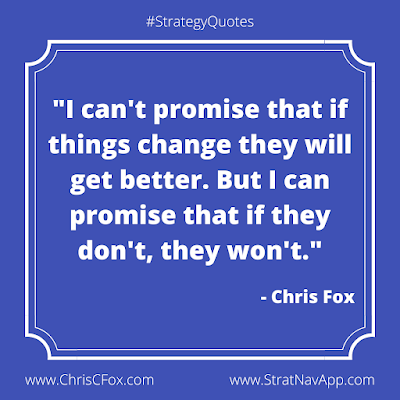Most people don't like change very much.
It can be difficult, uncomfortable, and the outcome is often uncertain.
In fact, as Niccolo Machiavelli said in The Prince: "There is nothing more difficult to take in hand, more perilous to conduct, or more uncertain in its success, than to take the lead in the introduction of a new order of things." (Tweet this)
But, without change, nothing would ever ... well ... change.
Not only might that get a little boring, but, as I always like to say: "I can't promise you that if things change they will get better, but I can promise you that if they don't, they won't." (Tweet this)
On the other hand, too much change leads to change fatigue. People become overwhelmed. They start to lose focus. They start to make mistakes.
So what is the right amount and rate of change? How much change do we really need? How much is too much? And how much is too little?
I draw on Ashby's Law for inspiration.
Ashby's Law (also known as The Law of Requisite Variety) states that: "When the variety or complexity of the environment exceeds the capacity of a system (natural or artificial) the environment will dominate and ultimately destroy that system." (Source) (Tweet this)
It seems we could adapt that to organisation change: "When the rate of change in the environment exceeds the rate of change in the organisation, the environment will ultimately destroy that organisation." (Tweet this)
So, the organisation must change at least as fast the external environment is changing.
That leaves us with three questions:
- How fast is the external environment changing?
- How quickly is the organisation changing?
- How can we increase the rate at which the organisation is changing (if we need to)?
A good SWOT analysis can and should help us answer the first two questions. The Opportunities and Threats will tell you how fast the external environment is changing. The Strengths and Weaknesses will tell you how fast the organisation is changing (or, at least, how fast it is capable of changing).
(See also: 12 techniques to help you do a better SWOT analysis.)
However, measuring the rate of change in an organisation or its internal environment is not an exact science. Some subject comparison will be required. This can be supplemented by gathering feedback from staff, customers, suppliers and other stakeholders.
Increasing the rate of change is even more tricky.
I would advocate the following:
- Break the change into the smallest chunks that produce meaningful results as possible. Pursue them, as much as possible, in series, rather than parallel. Smaller chunks are less daunting. Meaningful results create opportunities for real learning and encouragement to continue. Pursuing them in series rather than parallel limits the amount of change that is happening at any point in time. It also ensures that some results are delivered as quickly as possible.
- Be sure to articulate a clear vision about how all of those small changes add up to more than the sum of the parts. People need to understand the logic (the Logos) of what they are doing. Show the individual changes as a roadmap towards the vision.
- Create a safe environment for change. Things will inevitably go wrong. A safe environment defines outcomes not in terms of success or failure, but in terms of hypotheses tested, data gathered and learnings achieved. (See also: It's time we stopped idolising failure in innovation.)
If you have other ideas about how to determine and/or increase the right rate of change in organisations, I'd love to hear them. Please drop a note in the comments below.


No comments:
Post a Comment